Hiring looks different when your team spans time zones and your priorities change fast.
For B2B SaaS companies working remotely, choosing the right type of hire, freelancer, contractor, or full-time, can impact speed, delivery, and long-term results.
Each option brings trade-offs.
Freelancers move quickly but lack deep involvement. Contractors stay longer but may not be fully embedded. Full-time hires offer consistency, but they require a larger commitment upfront.
In Latin America, access to top talent is strong across all three models, but success depends on matching the structure to your goals.
This guide breaks down what each hiring type actually means, when it works, and how to avoid hidden costs.
If you’re growing a SaaS team and want to hire remote talent the smart way, start here.
What is a Freelancer Hire?
Hiring a freelancer means bringing in someone for a specific task, project, or short-term goal without making them an employee.
Freelancers are self-employed professionals who usually work with multiple clients and set their hours, rates, and tools. They’re often hired to handle time-sensitive projects or specialized tasks that don’t need full-time attention.
In Latin America, businesses often hire freelancers for design, writing, software development, or marketing support. Virtual assistants and finance experts are also typical freelance roles. With strong English fluency and time zone compatibility, Latin American talent has become a go-to option for fast-growing startups.
Freelancer hires can give you fast access to top remote talent without long hiring processes.
However, unlike employees or contractors, they usually don’t come with ongoing support or guarantees. It’s important to clearly define job description, scope, pay, and deadlines up front to avoid confusion or hidden costs later.
From content creation to code delivery, freelancers help companies fill skill gaps quickly, especially when looking to hire sales talent in Latin America for short-term needs.
What is a Contractor Hire?
A contractor is hired to work for a set period under a formal agreement, often full-time but without employee benefits. Unlike freelancers, contractors are deeply involved in a company’s day-to-day work, often embedded in teams.
When you hire in Latin America, contractors can be a strong option for roles like software development, finance, or sales. Latin American talent often brings professional experience, English fluency, and time zone compatibility, crucial for remote work with global teams.

Contractors are common in high-growth startups that want top-tier talent without making long-term commitments.
They’re paid per project or per month, and often deliver ongoing support within structured workflows.
The hiring process usually includes interviews, expectations setting, and legal documents. Companies working with LATAM talent must also consider local regulations and any hidden costs tied to the job or location.
From Costa Rica to South America, pre-vetted contractors help fill key roles quickly, without adding permanent headcount. It’s one reason why startups are turning to Brazil to hire developers, where talent depth and timezone compatibility match startup needs.
Contractor hires give you flexibility and access to the best fit for your position, especially when working with international teams or building remote talent across Latin America.
What is a Full-Time Employee?
Hiring a full-time employee means bringing someone onto your team with a formal contract, set hours, and a long-term role. They become part of your company’s structure, contributing consistently to key business outcomes.
When companies hire in Latin America, full-time roles often focus on software development, sales, finance, or marketing talent. Latin American professionals are known for strong communication skills, deep expertise, and reliable collaboration across time zones.
Unlike contractors or virtual assistants, full-time employees are committed to a single employer.
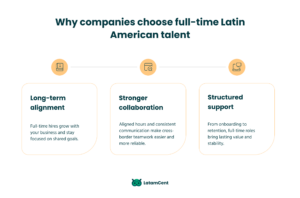
They attend meetings, work alongside global talent, and help drive company objectives. Overlapping schedules, especially with LATAM remote workers, help ensure effective communication within international teams.
The hiring process is more structured, companies often interview multiple candidates, outline expectations clearly, and provide ongoing support once the position is filled.
Salaries, benefits, and compliance with local laws affect cost, so hiring full-time in South America requires proper planning.
Still, when you’re looking for the right fit, someone to grow with your business and help lead success stories across teams, a full-time hire often offers the best combination of quality, commitment, and long-term value.
When is a Freelancer the Right Fit?
Freelancers make sense when you need expert help fast, without committing to a long hiring process.
They’re often the right fit for short-term needs, overflow work, or highly specific tasks like design, content, or marketing.
Hiring freelance remote talent in Latin America gives you access to top candidates with flexible schedules and in-demand skills. From marketing talent to developers, many deliver high quality results without the cost of full-time staff.
They’re handy when:
- You need to fill short-term gaps in your team
- The scope is clear and doesn’t need deep onboarding
- You want to test ideas before making long-term hires
- The cost of a full-time hire is too high for the project
- You need specialized expertise for a one-time task
If you’re launching something new or moving fast, a freelancer can offer support without adding overhead. For lean businesses, they reduce pay commitments while still contributing professional expertise.
Freelancers usually don’t require interviews beyond a short review.
Pre vetted platforms help match your business with top tier talent quickly. Just make sure expectations are clear, when communication works, freelancers deliver success that rivals your best talent.
When a Contractor Makes More Sense
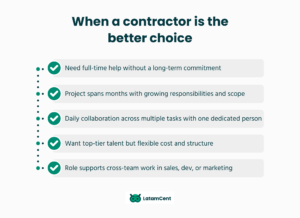
Contractors are a better fit when the work is ongoing, more involved, or requires full-time attention without a long-term commitment. They usually take on larger responsibilities and collaborate closely with your existing team.
Contractor hires are ideal when:
- You need dedicated remote talent without hiring an employee
- The project has clear goals but spans multiple months
- You want to work with one person daily across different tasks
- You require top tier talent but want flexibility in cost and scope
- The role demands collaboration with developers, sales, or marketing
Many companies hire in Latin America to access experienced professionals who can plug into teams quickly. These workers often bring quality, reliability, and English fluency, all useful when managing global teams and tight timelines.
Daily meetings can still run smoothly, learn how to run standups across time zones with nearshore teams.
Pre-vetted Latin American candidates can help reduce the interview process while still delivering top candidates for the job. With time zone compatibility, co-occurring schedules, and lower cost, South America is a strong source of skilled contractors.
If you need a perfect candidate for a project but not a full-time employee, a contractor might be the best fit.
Why Companies Choose Full-Time LATAM Hires
Hiring full-time in Latin America gives companies access to experienced professionals who want to grow with the business. These remote workers become part of the team, often taking ownership of key projects across sales, marketing, or software development.
For technical roles, nearshoring helps scale AI & ML teams by providing access to engineers already aligned with U.S. workflows.
Full-time LATAM hires are often the right choice when:
- You need consistent support across time zones
- The role is central to your team’s long-term goals
- You want to train and retain top talent over time
- The position needs ongoing collaboration with clients or other departments
Businesses looking to hire remote talent often choose pre-vetted Latin American candidates because they bring strong communication skills, cultural alignment, and high-quality output.
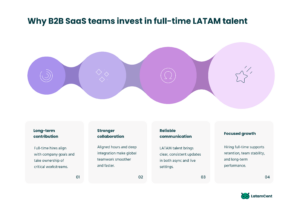
The hiring process may involve more steps, interviews, offer letters, and paperwork, but the payoff is long-term reliability. Companies frequently find the right candidate faster by limiting the search to LATAM, where cost, skill, and time zone alignment all work in their favor.
If you’re searching for the perfect candidate to lead growth and deliver strong results, a full-time hire in Latin America can offer the best value.
Legal & Financial Considerations When Hiring in LATAM
Employer of Record (EOR) vs. Direct Contracts
When hiring in Latin America, companies often choose between using an Employer of Record (EOR) or hiring via direct contracts. An EOR acts as the legal employer on paper, handling local payroll, taxes, and labor compliance.
Many employer of record (EOR) providers also offer additional HR support, easing expansion into multiple LATAM markets.
This option reduces risk and speeds up the onboarding process.
Direct contracts offer more flexibility but require businesses to manage agreements, track regulations, and avoid misclassification of employees. If you’re unfamiliar with labor laws in the worker’s country, direct hiring can carry hidden penalties or service interruptions.
EORs are often preferred for full-time hires. Contractors and freelancers are typically engaged via direct contracts, especially for short-term or project-based roles.
Payroll, Taxes, Benefits, & Compliance Risks
Labor laws in Latin America vary by country, and failing to comply can result in fines or legal disputes.
Full-time employees may be entitled to:
- Mandatory benefits like paid vacation, bonuses, and severance
- Government contributions for healthcare, pension, and insurance
- Country-specific tax filings and reporting rules
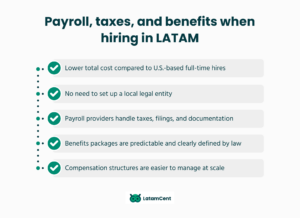
For companies hiring directly, it’s essential to stay updated on compliance requirements in each region. This includes knowing when someone qualifies as an employee vs. an independent contractor.
Using a payroll partner or legal advisor can help manage risk, especially if you’re scaling remote teams across multiple LATAM countries.
Cost Comparisons Across Employment Types
The cost of hiring varies widely depending on the structure.
Freelancers and contractors are often less expensive up front; they invoice only for hours or deliverables. But they usually don’t offer long-term continuity.
Full-time employees may cost more due to benefits, taxes, and employer obligations, but they tend to provide more consistent value.
Here’s a quick breakdown:
- Freelancers: Lowest commitment, flexible pricing, no benefits
- Contractors: Mid-range cost, project focus, some recurring expenses
- Full-Time: Higher fixed costs, but stronger retention and deeper team alignment
The right structure depends on your business goals, budget, and the level of responsibility tied to the role.
How to Decide What’s Best for Your B2B SaaS Company
Choosing between a freelancer, contractor, or full-time hire depends on your company’s current stage, internal bandwidth, and long-term plans.
Each option serves a different purpose, what matters is matching the structure to the problem you’re solving. Companies comparing staff augmentation vs outsourcing may find that hiring freelancers, contractors, or full-time LATAM professionals offers more flexibility and control.
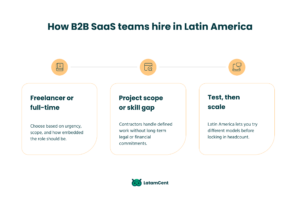
If you’re experimenting with a new service or filling short-term gaps, a freelancer offers fast, low-commitment help. Contractors work well when you need remote professionals who can stay focused on a project for months, without full-time employment logistics.
Full-time LATAM hires are ideal when you need someone embedded in the team, handling ongoing responsibilities, owning outcomes, and building institutional knowledge.
Start by reviewing:
- Your team’s current capacity and gaps
- The expected timeline for the work
- How much control, support, and consistency the role requires
- What level of legal and financial involvement your company is ready for
The right decision balances cost, complexity, and long-term value. For many fast-moving SaaS businesses, Latin America offers the flexibility to test multiple hiring models and scale once the fit is clear.
LatamCent Helps You Hire the Right Remote Workers, The Right Way
Hiring in Latin America doesn’t need to be slow, risky, or complicated.
At LatamCent, we connect fast-growing SaaS companies with pre-vetted talent across development, sales, marketing, finance, and customer success roles.
We handle the search, screening, interviews, and vetting, so you meet only the top candidates. You stay in control of the final hire.
What makes it work?
- Focus on top 10% LATAM talent with strong English fluency
- Most positions are filled in under 21 days
- Flat pricing, no markups, no long-term contracts
- Unlimited replacements or a 100-day guarantee
- Integrated directly with your stack: Slack, ATS, and more
From full-time developers to part-time marketing leads, we help you find the right fit faster, without the usual hiring stress. LatamCent is the top nearshoring and staffing agency for building teams in Latam, trusted by SaaS companies scaling across functions.
Conclusion
Freelancers, contractors, and full-time employees each serve a purpose, and no option is automatically better. The best fit depends on the scope of work, the support your team needs, and how long the role should last.
Latin America gives you flexibility across all three hiring models.
You’ll find top candidates with English fluency, time zone alignment, and strong technical and communication skills. But making the right decision still takes clarity, structure, and a trusted partner.
That’s where LatamCent comes in.
We help B2B SaaS companies hire top remote workers from Latin America, faster, with less guesswork. From sourcing to screening, we do the heavy lifting so you can focus on growth.
Need help finding the right fit? Get in touch with us and start your search today.



